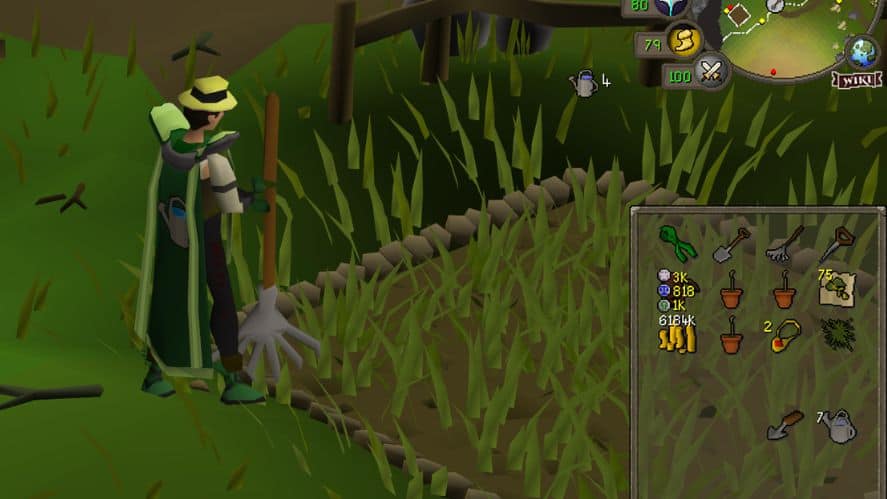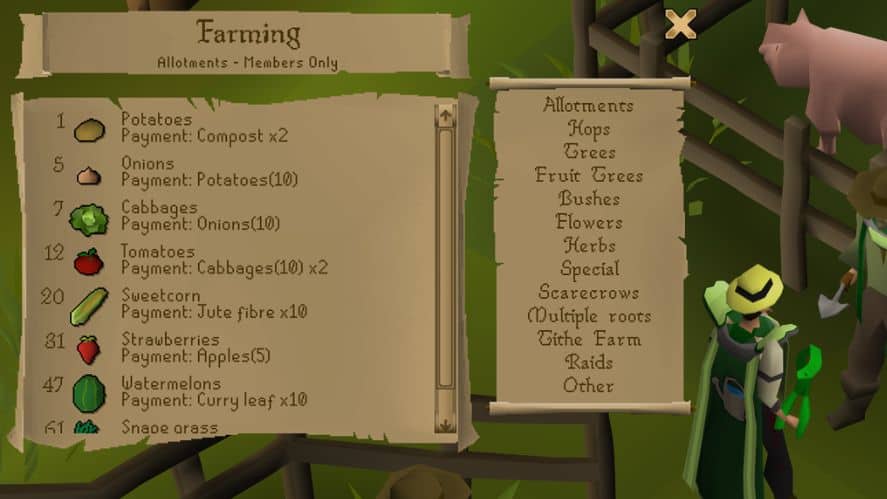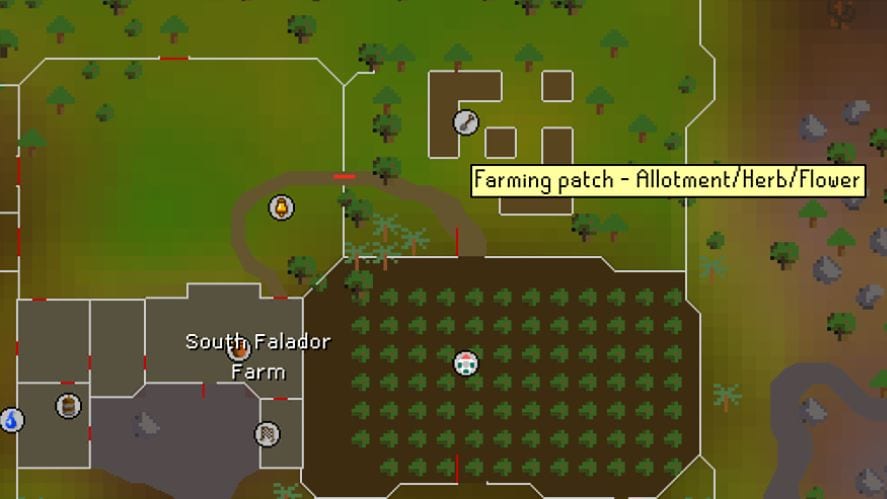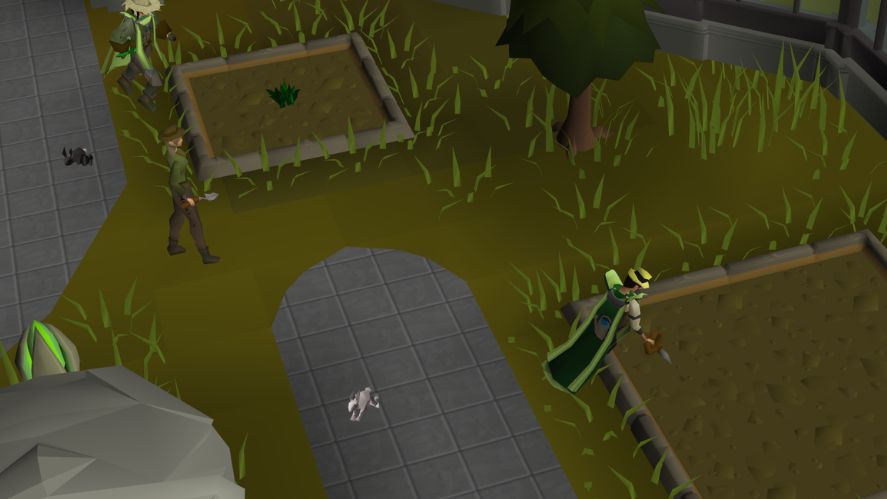Much like other MMORPGs, Old School RuneScape gives its players the freedom to farm their own crops, trees, and herbs that can be used for a variety of reasons. However, unlike other games, you don’t technically have your own farm in Old School RuneScape. Instead, you go to the patches scattered throughout Gielinor to farm at.
How Farming Works in OSRS
Farming in Old School RuneScape is unique from other skills in the fact that you do not train it with your own “farm” or location.
Unlike skills like Construction, where you have your own Player Owned House (POH) to build things with or Crafting, where you make the items yourself, you instead train Farming at other patches throughout OSRS.

The base concept of Farming is still self-explanatory: you plant seeds, take care of them, and wait for them to grow. The only difference is the method and where you plant your different types of produce.
What Can You Farm
You can farm different categories of produce in Old School RuneScape, each with its own purpose and value. These include:
- Allotments (Potatoes, Tomatoes, Watermelons, etc.)
- Flowers (Marigolds, Nasturiums, White Lilies, etc.)
- Hops (Barley, Jute, Asgarnians, etc.)
- Herbs (Ranarr, Snapdragon, Toadflax, etc.)
- Trees (Regular, Fruit, Special, Spirit)
The Herb and Tree patches are the most valuable of these patches (in terms of gold and Farming experience).
Herb runs are one of the most common ways to make passive money in OSRS while planting trees is considered the best way to train Farming all the way to level 99.


However, if you are just starting out with Farming, you may be limited to planting regular allotments or flowers until you reach higher levels.
Tools Used for Farming
Farming in Old School RuneScape requires the use of specific tools and supplies.
Some of these are hard requirements to grow a specific plant, while others are used to prevent disease, increase crop yield, or provide other benefits.
Rake
Used in all Farming patches, a Rake is used to remove any weeds that grow. Before you can plant a seed, you first need to ensure no weeds are in a patch.
Seed Dibbler
To be able to plant a seed in a patch, you need to have a Seed Dibbler in your inventory. Note that a Seed Dibbler is not used to plant a tree seed into a plant pot, as a Trowel is used instead.
Gardening Trowel
Used in preparation to make saplings for trees, a Gardening Trowel is used to plant tree seeds into a plant pot and to fill the plant pot with dirt from an allotment in the first place.
Spade
Spades are used in many other areas of OSRS. For Farming, however, it is used to harvest from fully grown allotments and tree patches.
Secateurs/ Magic Secateurs
For delicate crops like herbs, flowers, and tree roots, they will need to be harvested with Secateurs.
If you have completed the “Fairytale I – Growing Pains” quest, you will have yourself a set of Magic Secateurs. They serve the same function as regular Secateurs, and you will have 10% more harvest for whatever you are growing.
Watering Can
Used to water patches for crops that require it. Herb and tree patches do not need to be watered. However, regular allotments, flowers, and tree saplings need to be watered during the growing process.
Plant Cure
If you find that your crops have become diseased, you can use a Plant Cure to save them before they die.
Once they are dead, you will not be able to use a regular Plant Cure and will need to cast the “Resurrect Crops” spell from the Arceuus spellbook.
Compost/Supercompost/Ultracompost
Compost doubles in preventing your crops from being diseased and increasing your crop yield when you go to harvest.
There are three different kinds of compost: regular, supercompost, and ultracompost, each being more effective than the last.
Even if you are planting a crop at a disease-free patch (such as the herb patches in Weiss or Troll Stronghold), it is still recommended to fertilize the patch with compost to help increase your yield.
Where to Farm
Now that you have the equipment you need and seeds in your inventory, you are ready to go to a patch to start Farming.
There are dozens of patches throughout Old School RuneScape, each with its own types of allotments and requirements for use. Depending on what you are Farming, you will need to visit the associated patch to that plant.


For example: the most common farming spots have two allotment patches, one flower patch, and one herb patch, such as the one south of Falador next to Draynor Village.
If you are trying to plant a tree sapling, you will not be able to do it there and will need to find a tree patch.
Often referred to as “Herb Patches,” these Farming spots have all of the previously mentioned types of patches (minus a tree patch) and are used to complete herb runs.
Knowing this, they are the best locations to start Farming, as you can grow multiple types of crops at a time while often being next to a Farming shop/ bank for additional supplies.
Herb/Allotment/Flower Patch Locations:
- South of Falador
- North of Ardougne
- East of Canifis
- Hosidius
- Catherby
- Farming Guild
Note: While there are three other Herb patches in Old School RuneScape (Harmony Island, Troll Stronghold, and Weiss), they are standalone patches that do not have associated allotment and flower patches attached to them like the others.
Trees have their own category of patches and differing subgenres of trees to grow. There are regular, fruit, and special tree patches throughout OSRS that you will need to use.
Regular Patches
- West of Lumbridge Castle
- Falador Park
- Varrock Castle
- Taverley
- Tree Gnome Stronghold
- Farming Guild
Fruit Tree Patches
- East of Catherby
- Brimhaven
- North-West of Tree Gnome Village
- Tree Gnome Stronghold
- Lletya
- Farming Guild
Special Tree Patches
- Fossil Island (Mahogany and Teak Trees)
- Prifddinas (Crystal Trees)
- Farming Guild (Celerus and Redwood Trees)
Spirit Trees can also be grown starting at 83 Farming. These can be used to access the Spirit Tree teleportation network, which is fully unlocked once you complete the “Tree Gnome Village” quest.
Spirit Tree Patches
- Port Sarim
- Brimhaven
- Hosidius
- Etceteria
- Farming Guild
How to Farm
Once you have what you need and you are at the appropriate patch, you can begin Farming.
To start, use a Rake to clear the patch of any weeds. Weeds will have a chance to grow back at any time during the planting process (before you plant the seed), so be sure to rake them away when needed.
Afterward, use your compost on the patch (if you have it, although it is not required), then use the seed you want to grow on the patch with a Seed Dibbler in your inventory.
Your character will go through the animation of planting the seed, and it will begin to grow after a while!


